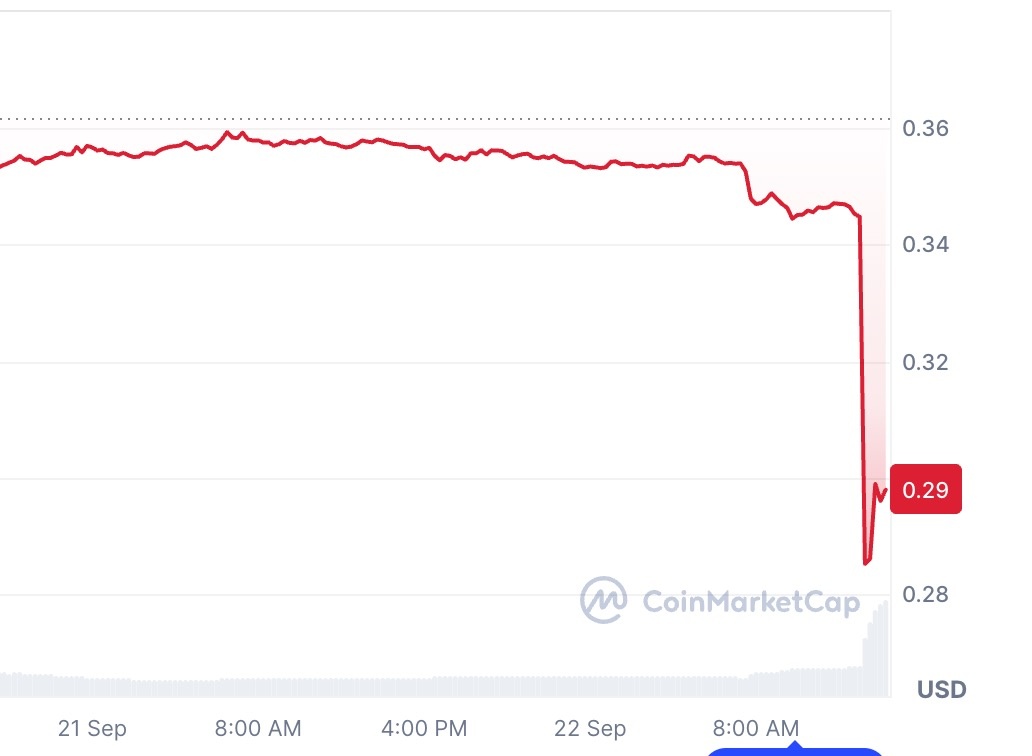 |
Pi price just hit an all-time low. |
On the afternoon of September 22, the price of Pi fell sharply. According to CoinMarketCap data, from 0.34 USD , it fell to 0.22 USD in just a few minutes. The drop was equivalent to 32% of the project's capitalization. This is also the lowest price ever recorded since the cryptocurrency opened its network and was listed on public exchanges.
After the crash, Pi Network recovered to $0.29 with strong selling pressure, trading volume 2-3 times higher than usual. Compared to the peak recorded at the beginning of the year at $2.98 , the above coin lost 92.5% of its value, divided by 13 times.
“I bought at $0.35 and thought that was the lowest and it would hold its value. Now it’s down to $0.22- $0.29 ,” one person commented on CoinMarketCap . Others tried to encourage the community to buy to prevent the price from collapsing.
 |
Pi price crashed sharply on the afternoon of September 22. Photo: CoinMarketCap. |
Since its listing, the developer has continuously launched products, providing new functions to attract users. However, these efforts have not shown effectiveness, unlike the blockchain present in the market.
Pi Network’s unusual way of operating also raises big questions about its current supply and token distribution. The project announced that there are 7.71 billion Pi in circulation. But how much of this amount is unlocked, how much the team and the exchange have is still a big question mark. On the other hand, it is always under selling pressure when a large amount of cryptocurrency is mined every day and the amount is “defrosted” after being frozen.
According to data from blockchain tracking platform Piscan, there are 163 nodes of the Pi Network blockchain platform located in Vietnam. Meanwhile, the project owns 334 processing points globally. This means that domestic users hold nearly half, equivalent to 49% of Pi's validator nodes.
Blockchain information identifies the distribution of nodes in Vietnam with 75 machines in the Northern region, 34 points in the Central region and 54 units in the Southern region. This number is many times higher than other regions with a large number of Pi miners such as China, India, Korea or Europe.
In addition to the tracking node, the validator is an important part in deciding whether a transaction is approved. Currently, Pi Network has only two such units globally. But they are under the management of the project development team, 100% control rate. Therefore, the decentralization of the blockchain platform is questioned.
The geographical concentration of monitoring nodes raises fairness concerns. Users in one country have significant control over the operation of the entire network.
Source: https://znews.vn/pi-network-bi-ban-thao-post1587351.html




![[Photo] National Assembly Chairman Tran Thanh Man attends the inauguration ceremony of the Memorial Site of National Assembly Standing Committee Chairman Bui Bang Doan](https://vphoto.vietnam.vn/thumb/1200x675/vietnam/resource/IMAGE/2025/9/28/6feba23492d14b03b05445dd9f1dba88)

























































































Comment (0)